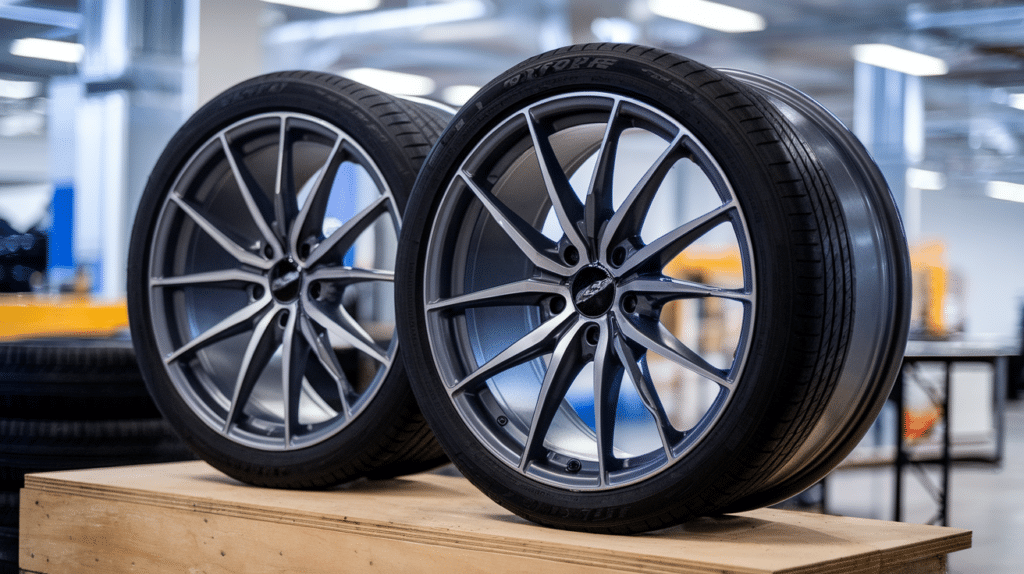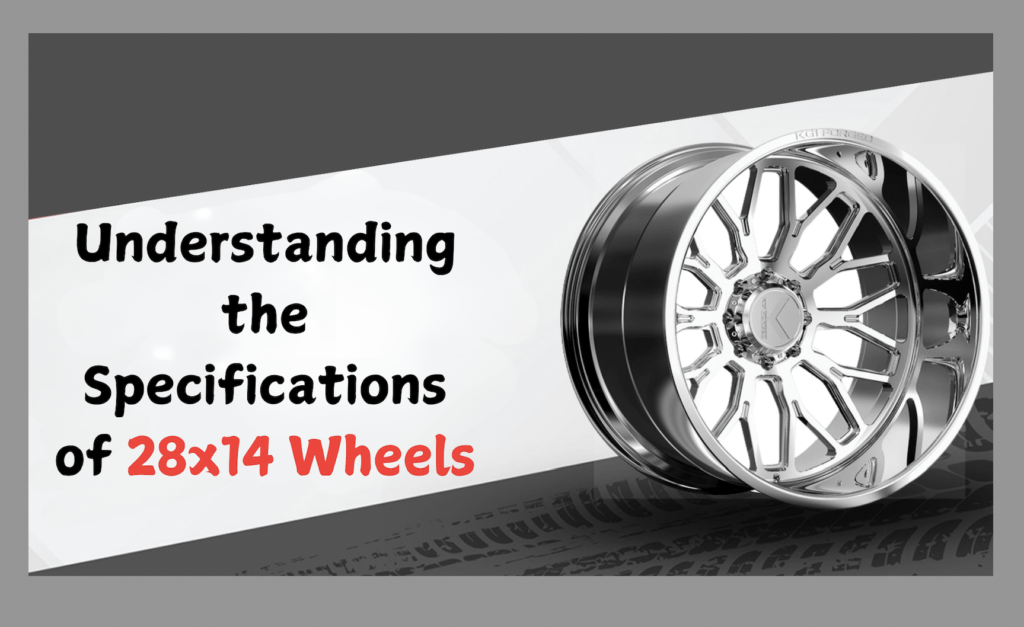As a wheel specialist with 15 years of experience, I know firsthand that choosing the right wheels can feel overwhelming. 28×14 wheels are becoming increasingly popular in the off-road and custom vehicle scene.
For a good reason – they offer that perfect blend of style and performance that many drivers seek.
Whether you’re planning an upgrade or just want to understand your current setup better, you’re in the right place.
In this guide, I’ll walk you through everything you need to know about 28×14 wheels, from fitment and backspacing to load ratings and compatibility.
You’ll learn how to avoid common sizing mistakes that could cost you hundreds of dollars and compromise your vehicle’s safety.
I’ve helped countless drivers make informed decisions about their wheel setups, and by the end of this article, you’ll have the knowledge to choose and maintain your 28×14 wheels with confidence.
Let’s move in and make sense of these impressive wheels together.
Understanding the 28×14 Wheels

What Are 28×14 Wheels?
When we talk about 28×14 wheels, we’re looking at some serious dimensions here. The “28” represents the total diameter in inches – that’s the distance from one edge of the wheel to the opposite edge through the center.
The “14” tells us the width in inches, measured from the inner lip to the outer lip.
Think of it like this: if you stood the wheel up against a wall, it would be about as tall as your waist (28 inches), and if you laid it flat, it would be wider than a standard laptop (14 inches).
These aren’t your average street wheels – they’re chunky, substantial pieces of equipment that make a statement.
Who Uses 28×14 Wheels?
From my experience working with various builds, these wheels are particularly popular among:
- Custom truck enthusiasts who want their ride to stand out
- Serious off-roaders tackling challenging terrain
- Show car builders aiming for that jaw-dropping look
- Performance truck owners seeking both style and function
Purpose and Appeal
There’s a reason why I recommend these wheels to certain clients. The wide footprint gives you excellent stability, especially when you’re dealing with rough terrain.
You’ll notice better traction in mud and sand compared to narrower wheels. Plus, the larger diameter means you can fit bigger brake components behind them – a huge plus for safety.
But let’s be honest – a big part of the appeal is how they look. When you roll up in a vehicle with 28x14s, people notice.
The aggressive stance these wheels create isn’t just for show; it actually improves your vehicle’s presence on the road and trail.
I’ve installed hundreds of these setups, and the transformation they bring to a vehicle’s appearance is remarkable.
Just remember: while these wheels look fantastic, you’ll need to consider factors like fender clearance and suspension modifications before making the switch. I’ll cover all that in the next sections.
Features to Look for in 28×14 Wheels
Material Quality
I’ve seen all types of wheel materials, but here’s what you need to know: forged aluminum is your best bet for 28×14 wheels. Why? It’s tough as nails but doesn’t weigh a ton.
Let me break it down:
- One-piece forged aluminum: The strongest option, perfect for heavy off-road use
- Flow-formed alloy: Great middle ground between strength and cost
- Cast aluminum: Budget-friendly but still durable for regular use
Tread Design
The tread design on 28×14 wheels isn’t just about looks. From my experience installing thousands of wheels, here’s what works:
Your wheel’s wide base creates a massive footprint, which means better stability. I’ve found that designs with deep grooves and reinforced shoulders work best for:
- Mud and loose terrain grip
- Water displacement
- Rock crawling traction
Finish Options
Listen, I’ve seen finishes come and go, but these are the ones that actually last:
- Powder coating: My top recommendation for durability
- Matte black: Hides dirt and scratches like a champ
- Chrome: Beautiful but needs more maintenance
- Brushed finish: Great middle ground for looks and upkeep
Bolt Pattern Compatibility
What’s something crucial that many folks overlook? Bolt pattern matching. You need to know your vehicle’s exact bolt pattern – it’s not something you can eyeball.
I always measure twice before recommending a wheel to my clients.
For example, if your truck has a 6×5.5 pattern, you’ll need wheels drilled specifically for that configuration. Getting this wrong means the wheels either won’t fit or could be dangerous to use.
Trust me, I’ve helped many customers who learned this the hard way.
Tip: Don’t forget to check the center bore diameter too – it’s just as important as the bolt pattern but often overlooked.
Popular Vehicle Models That Use 28×14 Wheels
| Vehicle Make & Model | Compatible Years | Bolt Pattern | Required Modifications | Typical Cost Range |
|---|---|---|---|---|
| Ford F-250 | 2011–2023 | 8×170 | • 4-6″ lift kit required• Upper control arm modification• Minor fender trimming | $2,500-3,500 |
| Chevrolet Silverado 1500 | 2015–2023 | 6×139.7 | • 6″ suspension lift minimum• Extended wheel studs• Fender modification | $3,000-4,000 |
| RAM 2500 | 2010–2023 | 8×165.1 | • 4″ lift kit minimum• Minor fender trimming• Wheel spacers (1.5″) | $2,000-3,000 |
| Toyota Tundra | 2007–2023 | 5×150 | • 6″ suspension lift• Aftermarket control arms• Significant fender modifications | $3,500-4,500 |
| GMC Sierra 2500 | 2015–2023 | 8×180 | • 4″ lift minimum• Fender liner removal• Crash bar modification | $2,800-3,800 |
| Dodge Ram 3500 | 2013–2023 | 8×165.1 | • 2″ spacer kit• Minor trimming• Track bar relocation | $1,800-2,500 |
Important Notes:
- These modifications are based on standard vehicle configurations
- Costs include professional installation
- Additional modifications may be needed based on specific wheel offset
- Always consult a professional for exact fitment details
Remember: Just because a wheel technically fits doesn’t mean it’s the best choice for your vehicle. Consider your driving habits and terrain before committing to this setup.
Benefits of Upgrading to 28×14 Wheels
Enhanced Off-Road Capabilities
From my years of testing wheels in various conditions, I can tell you that 28×14 wheels are game-changers for off-road performance.
The extra width gives you a massive contact patch with the ground, which translates into exceptional stability when you’re tackling rough terrain.
I’ve seen drivers navigate through mud pits and over rock gardens with significantly more confidence after upgrading.
The wider footprint helps distribute your vehicle’s weight more evenly, reducing the chances of getting stuck in challenging situations.
Improved Elegant Appeal
These wheels make a statement. I’ve installed countless sets, and the transformation never fails to impress. The bold presence of 28×14 wheels completely changes your vehicle’s stance, giving it that head-turning look that stands out from stock setups.
When paired with the right lift kit and tire combination, these wheels create that perfect aggressive profile that many truck and SUV owners are after.
Increased Ground Clearance
Something many people don’t realize until they make the switch: 28×14 wheels can significantly improve your ground clearance.
I’ve helped customers gain valuable inches of clearance, which makes a real difference when you’re navigating over rocks, logs, or deep ruts.
This extra height isn’t just for show – it provides practical benefits for both off-road enthusiasts and drivers who frequently encounter rough terrain.
Customization Options
One aspect I particularly enjoy about 28×14 wheels is the incredible range of customization possibilities.
Whether you’re looking for a classic chrome finish, a stealthy matte black, or something more unique like bronze or machined faces, there’s a style out there for every taste.
I’ve worked with customers to create some truly unique builds, and the width of these wheels provides an excellent canvas for custom finishes and designs.
You’re not just buying a wheel, you’re investing in a key piece of your vehicle’s personality.
Tip: When choosing your customization options, consider your vehicle’s color and overall style – the right wheel finish can either complement or contrast with your paint job for maximum impact.
Comparing 28×14 Wheels to Other Sizes
| Feature | 28×14 Wheels | 24×12 Wheels | 20×10 Wheels |
|---|---|---|---|
| Ground Clearance | • 4-6″ higher than stock• Excellent obstacle clearance• Best for extreme terrain | • 2-3″ higher than stock• Good daily clearance• Suitable for light trails | • 1-2″ higher than stock• Standard clearance• Street-oriented |
| Aesthetic Impact | • Dominates wheel wells• Aggressive stance• Show-stopping presence | • Fills wheel wells nicely• Modern look• Clean appearance | • Conservative styling• Factory-plus look• Subtle enhancement |
| Off-Road Performance | • Superior traction• Best mud/rock handling• Maximum stability | • Good all-around grip• Decent trail performance• Balanced capability | • Limited off-road use• Better for street• Standard handling |
| Required Modifications | • 4-6″ lift minimum• Fender modifications• New control arms• Cost: $2,500-4,500 | • 2-3″ lift needed• Minor trimming• Basic modifications• Cost: $1,500-2,500 | • Minimal lifting• Stock suspension ok• Basic spacers maybe• Cost: $500-1,000 |
| Fuel Economy Impact | -3 to -5 MPG | -1 to -2 MPG | Minimal change |
| Installation Time | 8-12 hours | 4-6 hours | 2-3 hours |
Additional Considerations:
- Prices include professional installation
- Fuel economy impact varies by vehicle and driving style
- Warranty implications differ by manufacturer
- Installation complexity increases with size
Pro tip: If you’re on the fence, I usually recommend starting with 24×12 wheels. They offer a great balance of looks and practicality without requiring extensive modifications.
How to Maintain and Care for 28×14 Wheels?
Cleaning Routine
After working with these wheels for years, I’ve developed a foolproof cleaning method that keeps them looking fresh. Start by rinsing with plain water to remove loose dirt – this prevents scratching during the main wash.
Then, use a pH-neutral wheel cleaner specifically designed for your wheel’s finish. I’ve seen too many beautiful wheels damaged by harsh chemicals.
For best results:
- Clean every 2-3 weeks for daily drivers
- Use a soft brush with long bristles to reach behind the spokes
- Never clean when wheels are hot from driving
- Rinse thoroughly to prevent cleaner residue
Inspect for Damage
Regular inspections can save you thousands in wheel replacement costs. Here’s my tried-and-tested inspection routine:
Run your fingers along the inner and outer barrel to feel for:
- Bends from hitting curbs or rocks
- Hairline cracks near the lug holes
- Unusual wear patterns that might indicate alignment issues
If you hear any unusual vibrations or feel the steering wheel shimmy, get your wheels checked immediately.
Protective Measures
Having protected hundreds of wheel sets, I can tell you that prevention is crucial. Apply a ceramic wheel coating or high-quality sealant every 6 months. This creates a protective barrier that:
- Repels brake dust
- Makes future cleaning easier
- Prevents oxidation
- Protects against road salt
Proper Tire Pressure
Something I always emphasize to my clients: proper tire pressure is absolutely critical with 28×14 wheels. Due to their size, they’re more sensitive to pressure changes. I recommend:
- Checking pressure weekly when the tires are cold
- Adjusting for load and terrain conditions
- Using high-quality valve stems
- Installing a tire pressure monitoring system
Tip: Keep a log of your pressure readings. This helps spot slow leaks before they become a problem and ensures even wear across your expensive tire setup.
Remember: These wheels are an investment. A little regular maintenance goes a long way in protecting that investment and keeping your ride looking sharp.
Tips for Choosing the Right 28×14 Wheels
Match Your Vehicle’s Bolt Pattern
I can’t stress this enough – getting the bolt pattern right is absolutely crucial. Throughout my career, I’ve seen too many eager buyers rush into purchases without checking this vital detail.
First, locate your vehicle’s bolt pattern in the owner’s manual or measure it yourself. Remember that both the pattern and the center bore must match perfectly.
A wheel might look perfect, but if the bolt pattern is off by even a few millimeters, it simply won’t work.
Consider Driving Needs
From my experience fitting wheels for different drivers, your usage pattern should drive your choice. Here’s how I break it down:
For off-road enthusiasts
- Look for reinforced inner lips
- Choose beadlock-capable designs
- Prioritize strength over weight
For show vehicle owners
- Focus on unique finishes
- Consider multi-piece construction
- Look for intricate spoke patterns
For daily drivers
- Balance weight and durability
- Select easy-to-clean designs
- Choose corrosion-resistant finishes
Research Modifications Required
I’ll be straight with you, fitting 28×14 wheels usually requires significant modifications. Based on hundreds of installations, here’s what you typically need:
- A minimum 4-6 inch suspension lift
- Extended wheel studs or spacers
- Fender modifications
- Upgraded brake lines
- Steering geometry corrections
Consult Professionals
After seeing countless DIY attempts go wrong, I strongly recommend professional consultation. A qualified wheel specialist can:
- Measure your exact fitment requirements
- Identify potential clearance issues
- Recommend specific modifications
- Ensure proper load ratings
- Calculate correct offset needs
Tip: Before making any purchase, get a written estimate for both the wheels AND all required modifications. I’ve seen too many projects stall halfway because buyers didn’t account for the full scope of work needed.
Conclusion
After spending 15 years working with these wheels, I can tell you that 28x14s are more than just a style choice – they’re a serious upgrade that can transform your vehicle’s capabilities.
Whether you’re crawling rocks on weekends or turning heads at car shows, these wheels deliver when installed correctly.
Remember, success with 28×14 wheels comes down to three key things: matching your vehicle’s specs perfectly, being ready for the necessary modifications, and maintaining them properly.
Yes, they’re a bigger investment than standard wheels, both in money and effort, but the results are worth it when done right.
My final piece of advice? Take your time researching and budgeting for quality components, and work with experienced professionals for installation.
Your vehicle deserves that extra care, and you’ll appreciate the peace of mind that comes with a properly executed setup.
Frequently Asked Questions
What is the Average Cost of Installing 28×14 Wheels?
Based on my experience, a complete 28×14 wheel setup typically costs between $4,000-$6,000. This includes quality wheels, tires, necessary lift kits, and professional installation.
Remember, cutting corners on installation can lead to costly problems down the road.
How Much Lift Do I Need for 28×14 Wheels?
You’ll need at least a 4-6 inch lift kit for most vehicles. I’ve installed hundreds of these setups, and anything less usually results in rubbing issues.
The exact height depends on your vehicle model and intended use.
Will 28×14 Wheels Affect My Fuel Economy?
Yes, they will. From what I’ve seen with my clients, expect a 2-5 MPG decrease in fuel efficiency. The impact varies based on your driving style, vehicle type, and the weight of your specific wheel/tire combination.
Can I Daily Drive with 28×14 Wheels?
While possible, I usually recommend considering your driving habits carefully. These wheels are best suited for weekend warriors and show vehicles.
Daily driving requires more frequent maintenance, careful parking (they’re wide!), and tolerance for a slightly stiffer ride.
How Often Should I Rotate 28×14 Wheels?
I recommend rotation every 5,000-6,000 miles for even wear. However, if you’re doing serious off-roading, check them more frequently.
I’ve seen uneven wear develop quickly when rotation is neglected, especially with these larger sizes.


